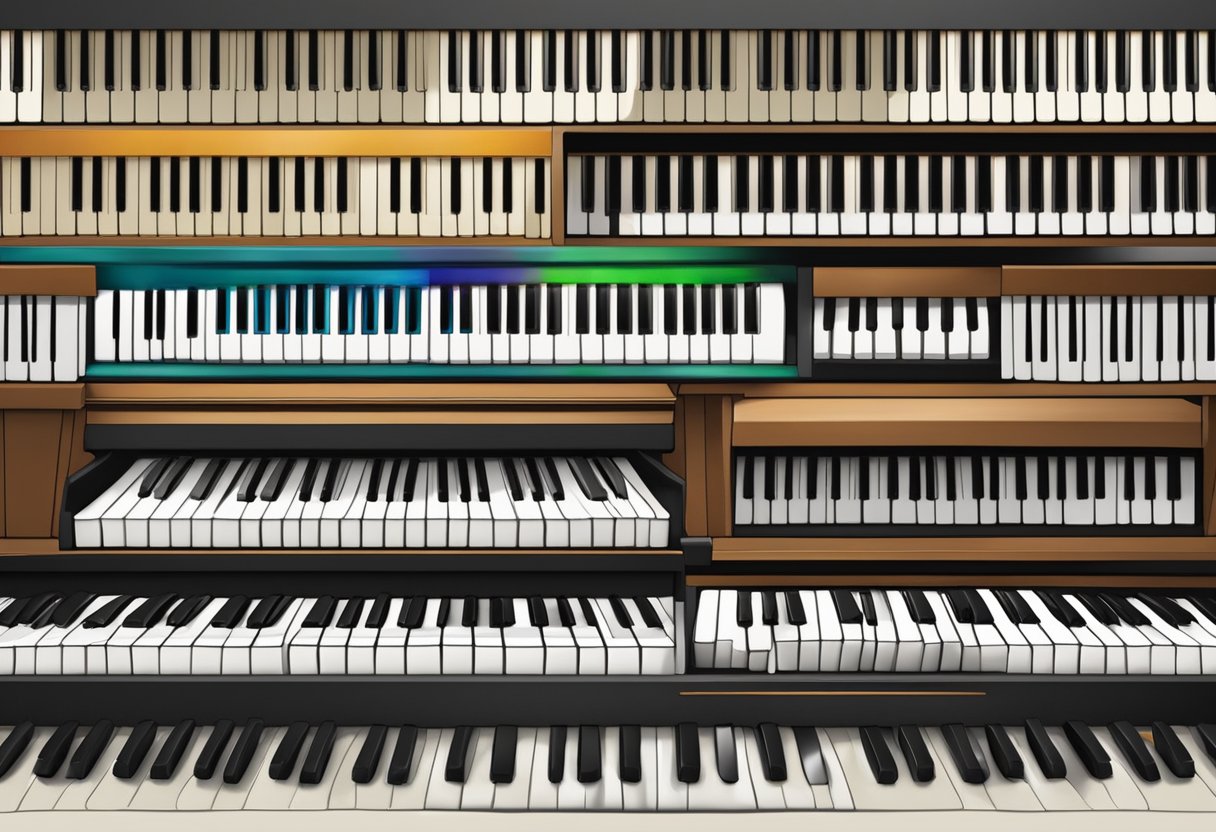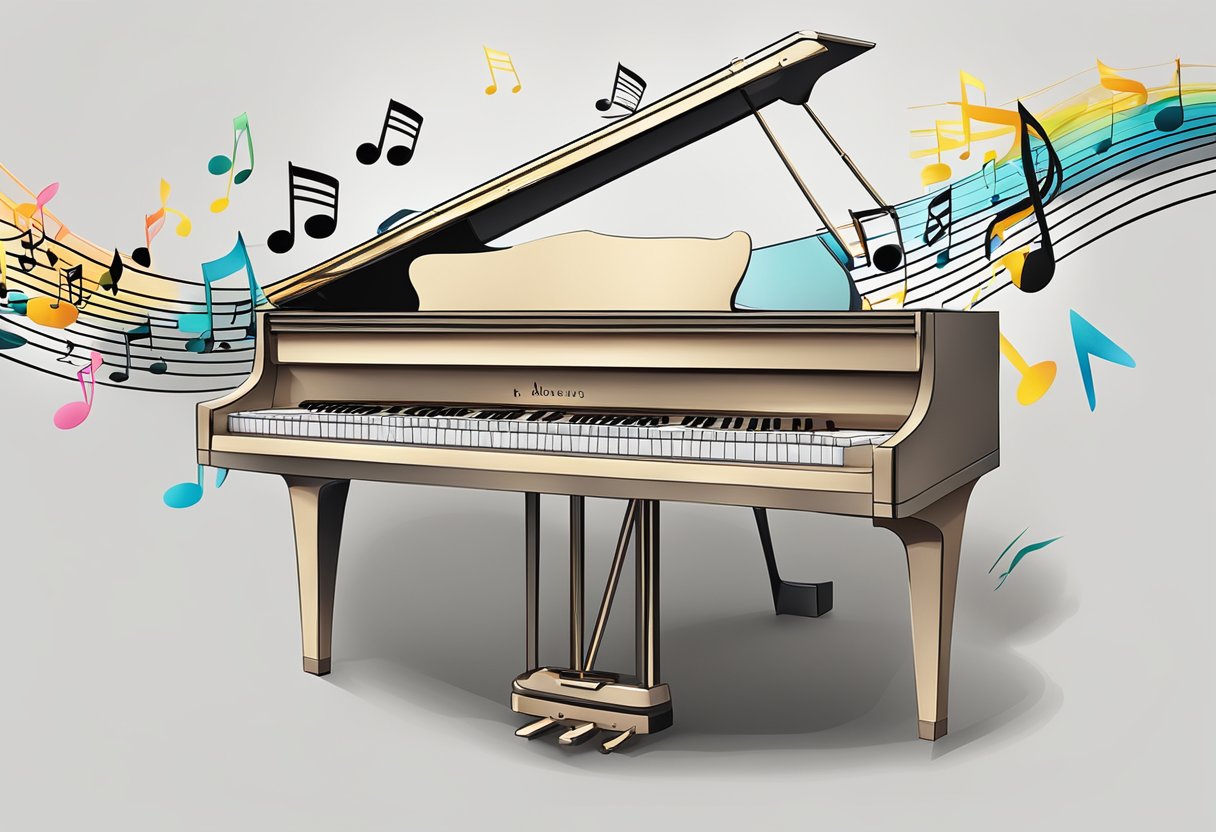As an Amazon Associate I earn from qualifying purchases.
A piano and a keyboard are not the same, even though they share some similarities. For instance, both instruments have keys that are played by the musician to produce notes and melodies.
But let’s talk about touch: when you press a key on a piano, you’re activating a hammer that strikes a string, creating the piano’s signature sound. With a keyboard, the story is different; pressing a key initiates an electronic tone that’s typically been pre-recorded or synthesized.
Want to Learn Piano?Click Here

The feel of a piano’s keys, which reflects the instrument’s mechanical complexity, offers a range of dynamics based on how softly or firmly you play them. This can be a crucial aspect for emotive and expressive performance.
During my years teaching piano, I’ve seen students discover the joy of dynamics—their eyes light up when they learn how their touch can change the mood of a piece. Keyboards, while they may offer touch sensitivity, generally lack the weight and resistance of piano keys, leading to a different playing experience.
Moreover, the number of keys is a telltale difference; a standard piano has 88 keys, while keyboards can vary widely, from as few as 25 for portable models to 88 for full-sized versions.
Do remember, though, some high-end keyboards are designed to mimic the touch and feel of an acoustic piano, equipped with weighted keys that can offer a comparable tactile experience, but if you want the true resonance and acoustic nuances of a piano, nothing beats the real thing.
Understanding the Basics

When you step into the world of keyboards and pianos, it’s essential to grasp the key differences and features of each. These instruments might seem similar at a glance, but they offer distinct experiences in terms of playability, sound, and function.
Defining the Keyboard and Piano
In your musical journey, you’ll encounter both keyboards and pianos, two instruments that share a basic layout but differ fundamentally. A piano is an acoustic instrument with a rich history, having strings that vibrate when its keys are pressed and hammers strike them.
It’s known for its dynamic range and the nuanced control it allows over the sound. You’ll find two main types: the large, grand grand piano with its iconic horizontal frame and the compact, vertical upright piano, both beloved for their weighted keys and complex action.
On the flip side, a keyboard is an electronic device that can mimic various instruments, including the piano. It stands out due to its versatility and often contains a wide array of built-in rhythms and sounds, from synthesizers to orchestral tones.
Most keyboards are lightweight and portable, making them a go-to for musicians on the move.
Types of Pianos and Keyboards
When delving into the types of these instruments, you’ll discover a few key variants:
- Acoustic Pianos:
- Grand Pianos: They are the largest, with a wide range of sizes and known for their superior sound quality and aesthetic presence.
- Upright Pianos: More suited for home or practice spaces due to their smaller footprint.
- Electronic Instruments:
- Digital Pianos: These aim to replicate the touch and sound of an acoustic piano but in a digital format, often with weighted keys to mimic the piano’s action.
- Electronic Keyboards: They vary greatly in size, often starting at 61 keys, as opposed to the full 88 found on most pianos. They are highly adaptable, with options to change volume and add effects.
- Synthesizers: These are a type of keyboard dedicated to creating new sounds and often used in electronic music production.
Whether your interest lies in the authenticity of an acoustic piano or the innovation of an electronic keyboard, understanding these distinctions is crucial.
Comparing Features and Considerations
When choosing between a piano and a keyboard, it’s important to consider their features side by side. From the sound quality to the practicality of each instrument, these factors are crucial in making an informed decision that suits your needs as a musician.
Tonal Quality and Sound Range
The tonal quality and sound range of a piano and a keyboard can be quite different. A traditional piano offers a rich and authentic sound that comes from hammers striking strings, resonating through a wooden soundboard.
In contrast, keyboards generate tones through sampling or synthesis, which can result in a wide variety of sounds and effects. High-end keyboards may offer sophisticated sampling that closely mimics an acoustic piano, but they may still lack the subtle dynamics and overtones produced by a real piano.
Physical and Technical Characteristics
Pianos have 88 weighted keys that provide a sensitive key action, allowing for nuanced play. This weighted feel is a key part of developing proper finger technique and strength. Keyboards, however, vary in the number of keys and may have non-weighted or semi-weighted keys.
While some keyboards have weighted keys and mimic the touch of a piano, they often have a smaller number of keys and may lack pedals that alter the sound’s sustain and dynamics.
- Piano: 88 weighted keys, key action that resembles real piano feel.
- Keyboard: Range of key options, often with lighter touch and adjustable settings.
Practical Aspects for Users
Considering the practical aspects, keyboards boast portability and often come with built-in speakers, making them suitable for a space-conscious or mobile musician.
Additionally, modern keyboards can include MIDI connectivity and Bluetooth capabilities, which are useful for home recording or using music instruction apps. Conversely, pianos require more space and regular maintenance, including tuning, which can add to the overall cost.
Cost and Budget: Pianos usually present a higher initial price and maintenance costs, while keyboards offer a more budget-friendly alternative with minimal upkeep. Space and Portability: If space is limited or you need something easily movable for practice and performances, a keyboard may be the better choice.
As you weigh these features, consider what’s essential for you, whether it’s the authentic feeling of playing on a traditional piano or the versatility and convenience of a keyboard.
Hello & thanks for stopping by! I’m a professional concert pianist and piano instructor. In the United States, I’ve given successful performances in several places including New York, Florida, Connecticut, & New Jersey, I have also performed internationally in Italy and made my Carnegie Hall debut in 2014. I enjoy blogging about the piano, the art of performance, general music, current events and the latest in music production.
